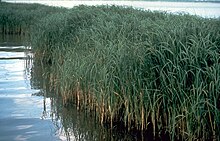
An invasive or alien species is an introduced species to an environment that becomes overpopulated and harms its new environment. Invasive species adversely affect habitats and bioregions, causing ecological, environmental, and/or economic damage. The term can also be used for native species that become harmful to their native environment after human alterations to its food web – for example, the purple sea urchin which has decimated kelp forests along the northern California coast due to overharvesting of its natural predator, the California sea otter. Since the 20th century, invasive species have become a serious economic, social, and environmental threat worldwide.

A salt marsh, saltmarsh or salting, also known as a coastal salt marsh or a tidal marsh, is a coastal ecosystem in the upper coastal intertidal zone between land and open saltwater or brackish water that is regularly flooded by the tides. It is dominated by dense stands of salt-tolerant plants such as herbs, grasses, or low shrubs. These plants are terrestrial in origin and are essential to the stability of the salt marsh in trapping and binding sediments. Salt marshes play a large role in the aquatic food web and the delivery of nutrients to coastal waters. They also support terrestrial animals and provide coastal protection.

Spartina is a genus of plants in the grass family, frequently found in coastal salt marshes. Species in this genus are commonly known as cordgrass or cord-grass, and are native to the coasts of the Atlantic Ocean in western and southern Europe, north-western and southern Africa, the Americas and the islands of the southern Atlantic Ocean; one or two species also occur on the western coast of North America and in freshwater habitats inland in the Americas. The highest species diversity is on the east coasts of North and South America, particularly Florida. They form large, often dense colonies, particularly on coastal salt marshes, and grow quickly. The species vary in size from 0.3–2 m tall. Many of the species will produce hybrids if they come into contact.

Sporobolus anglicus is a species of cordgrass that originated in southern England in about 1870 and is a neonative species in Britain. It was reclassified as Sporobolus anglicus after a taxonomic revision in 2014, but Spartina anglica is still in common usage. It is an allotetraploid species derived from the hybrid Sporobolus × townsendii, which arose when the European native cordgrass Sporobolus maritimus hybridised with the introduced American Sporobolus alterniflorus.

Sporobolus maritimus, or synonymously as Spartina maritima, the small cordgrass, is a species of cordgrass native to the coasts of western and southern Europe and western Africa, from the Netherlands west across southern England to southern Ireland, and south along the Atlantic coast to Morocco and also on the Mediterranean Sea coasts. There is also a disjunct population on the Atlantic coasts of Namibia and South Africa.

Littoraria irrorata, also known by the common name the marsh periwinkle, is a species of sea snail, a marine gastropod mollusk in the family Littorinidae. The specific epithet irrorata means 'moistened' or 'dewy.'
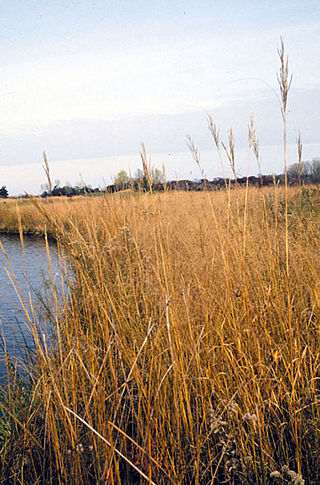
Sporobolus michauxianus is a species of cordgrass known as prairie cordgrass, freshwater cordgrass, tall marshgrass, and sloughgrass. It is native to much of North America, including central and eastern Canada and most of the contiguous United States except for the southwestern and southeastern regions. Its distribution extends into Mexico. It is also present on other continents as an introduced species.

Salt pannes and pools are water retaining depressions located within salt and brackish marshes. Pools tend to retain water during the summer months between high tides, whereas pannes generally do not. Salt pannes generally start when a mat of organic debris is deposited upon existing vegetation, killing it. This creates a slight depression in the surrounding vegetation which retains water for varying periods of time. Upon successive cycles of inundation and evaporation the panne develops an increased salinity greater than that of the larger body of water. This increased salinity dictates the type of flora and fauna able to grow within the panne. Salt pools are also secondary formations, though the exact mechanism(s) of formation are not well understood; some have predicted they will increase in size and abundance in the future due to rising sea levels.

Sporobolus montevidensis is a species of grass known by the common name denseflower cordgrass. Although reclassified after a taxonomic revision in 2014, it may still be referred to as Spartina densiflora by some users. It is native to the coastline of southern South America, where it is a resident of salt marshes. It is also known on the west coast of the North America and parts of the Mediterranean coast as an introduced species and in some areas a noxious weed. In California it is a troublesome invasive species of marshes in San Francisco Bay and in Humboldt Bay, where it was introduced during the 19th century from Chile in ballast.

Sporobolus foliosus is a species of grass known by the common name California cordgrass. It was reclassified from Spartina foliosa after a taxonomic revision in 2014. It is native to the salt marshes and mudflats of coastal California and Baja California, especially San Francisco Bay. It is a perennial grass growing from short rhizomes. It produces single stems or clumps of thick, fleshy stems that grow up to 1.5 meters tall. They are green or purple-tinged. The long, narrow leaves are flat or rolled inward. The inflorescence is a narrow, dense, spike-like stick of branches appressed together, the unit reaching up to 25 centimeters long. The lower spikelets are sometimes enclosed in the basal sheaths of upper leaves.
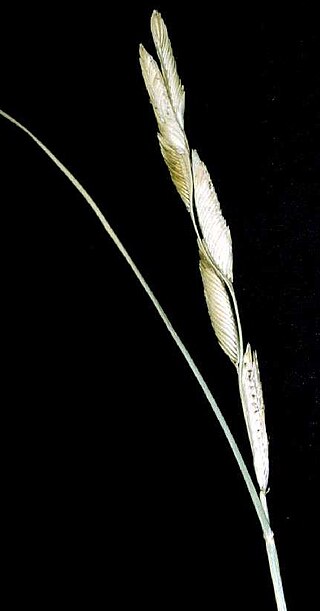
Sporobolus hookerianus is a species of grass known by the common name alkali cordgrass.
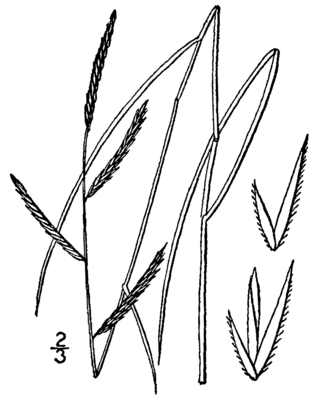
Sporobolus pumilus, the saltmeadow cordgrass, also known as salt hay, is a species of cordgrass native to the Atlantic coast of the Americas, from Newfoundland south along the eastern United States to the Caribbean and north-eastern Mexico. It was reclassified after a taxonomic revision in 2014, but the older name, Spartina patens, may still be found in use. It can be found in marshlands in other areas of the world as an introduced species and often a harmful noxious weed or invasive species.
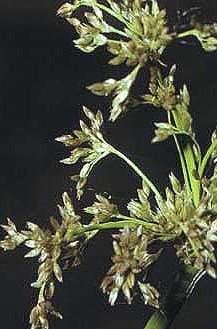
Juncus roemerianus is a species of flowering plant in the rush family known by the common names black rush, needlerush, and black needlerush. It is native to North America, where its main distribution lies along the coastline of the southeastern United States, including the Gulf Coast. It occurs from New Jersey to Texas, with outlying populations in Connecticut, New York, Mexico, and certain Caribbean islands.

Sporobolus cynosuroides is a species of grass known by the common names big cordgrass and salt reedgrass. It is native to the East Coast and Gulf Coast of the United States, where it grows in coastal habitat such as marshes, lagoons, and bays.

Sporobolus spartinae is a species of grass known by the common names gulf cordgrass and sacahuista. It is native to the Americas, where it occurs from the Gulf Coast of the United States south to Argentina.

Salt marsh die-off is a term that has been used in the US and UK to describe the death of salt marsh cordgrass leading to subsequent degradation of habitat, specifically in the low marsh zones of salt marshes on the coasts of the Western Atlantic. Cordgrass normally anchors sediment in salt marshes; its loss leads to decreased substrate hardness, increased erosion, and collapse of creek banks into the water, ultimately resulting in decreased marsh health and productivity.
The Kendall-Frost Mission Bay Marsh Reserve is a 20-acre University of California Natural Reserve System reserve on the northern shore of Mission Bay in San Diego County, California. Administered by UC San Diego, the site is owned by the University of California and managed for teaching and research.
Nonnative grasses that are invasive in Brazil include Arundo donax, Rottboellia cochinchinensis, Cortaderia selloana, Nassella neesiana, Spartina densiflora, and Spartina alterniflora. These species have been identified and are being managed by the Ministry of Environment and Forest.

Hooks Island is an uninhabited, approximately 36-acre (15 ha) tidal salt marsh island in San Francisco Bay, in Palo Alto, California, United States. In the 2010s, it was observed to be a home for tens of near-endangered California clapper rails.
Spartina townsendii is a species of flowering plant in the family Poaceae. It is native to Western Europe.
